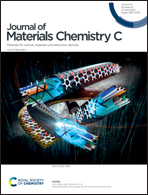High-performance multivalued logic circuits based on optically tunable antiambipolar transistors†
Abstract
Antiambipolar transistors (AATs) have attracted enormous attention in recent years due to their potential application to multivalued logic circuits (MVLs). A wide variety of materials have been actively investigated for the realization of high-performance AATs and MVLs. Organic semiconductors have emerged as promising candidates in this regard because of their simple fabrication and patterning techniques. In this work, an AAT is developed by adopting these advantageous characteristics and employing 2,7-dioctyl[1]benzothieno[3,2-b][1]benzothiophene (C8-BTBT) and PhC2H4-benzo[de]isoquinolino[1,8-gh]quinolone diimide (PhC2-BQQDI) as p-type and n-type semiconductors, respectively. Due to the high charge carrier mobility of these organic semiconductors, the AATs exhibit a high on/off ratio of 106 and the AAT-based ternary inverters show a complete output voltage sweep from drain voltage to ground voltage. Then, an efficient technique of device geometry engineering is demonstrated to further improve the voltage transfer characteristics (VTC) of the ternary inverters. However, the ternary inverter property was still not sufficient for the practical applications because of a low static noise margin (SNM). Finally, the contrasting photoresponsivity of the channel layers under ultraviolet light irradiation overcomes the drawback. The optical tunability of the AATs consequently achieves well-balanced VTC with high SNM of 76%. Our devices, thus, reveal their great potential for future opto-electronic logic applications.



 Please wait while we load your content...
Please wait while we load your content...